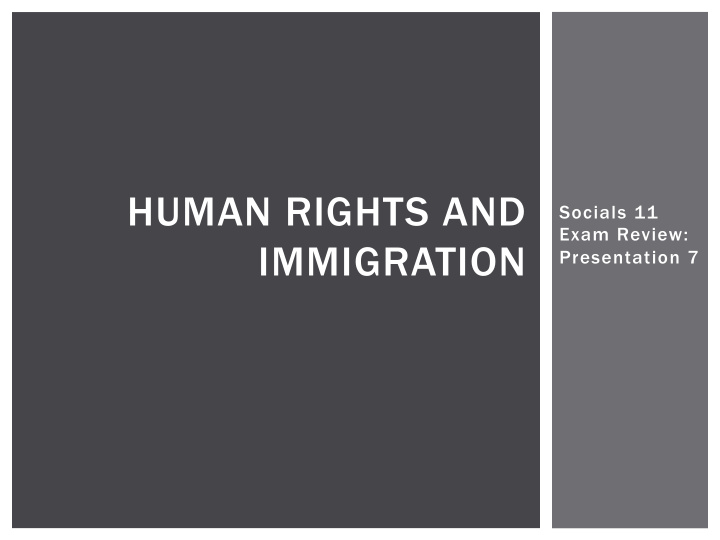



HUMAN RIGHTS AND Socials 11 Exam Review: IMMIGRATION Presentation 7
HUMAN RIGHTS IN CANADA ¡ Human Rights haven’t always been acknowledged in Canada ¡ Canada did not formally list rights of citizens until the Charter of Rights and Freedoms in 1982 ¡ The Charter of Rights and Freedoms was developed when Canada decided to have their own constitution, separate from England’s ¡ This was called “Repatriation.” Before then Canada was a dominion of Britain. With repatriation Canada become a country in it’s own right—not ruled by Britain. ¡ The Constitution defines the powers of the government in Canada ¡ At this time the Charter of Rights and Freedoms was added.
REPATRIATION
THE CHARTER OF RIGHTS AND FREEDOMS ¡ Created in 1982 when Constitution was repatriated ¡ Lays out basic civil rights. Limits the power of governments. ¡ No Note: T : The he Char Charter is about pre r is about preventing go nting governme rnments fr nts from om vi violati ting r g rights. ghts. I It d t does n es not a t apply t to i indivi viduals, s, b busi sinesses o esses or organiz organizations. ations. ¡ Fundamental Freedoms: § Freedom of conscience, religion, speech, expression, belief § Freedom of peaceful assembly ¡ Democratic Rights: § Right to vote
¡ Mobility Rights: Freedom to move around Canada and go outside of Canada ¡ Legal Rights: § Right to life, liberty and security of person § Freedom from unreasonable search and seizure § Innocent until proven guilty § Freedom from illegal imprisonment, cruel and unusual punishment ¡ Equality Rights § Equal treatment under the law (no discrimination)
¡ Language Rights: § French and English are official languages § Right for minority English or French language communities to be educated in their own language Aboriginal Rights (in Constitution) ¡ 35. (1) The existing aboriginal and treaty rights of the aboriginal peoples of Canada are hereby recognized and affirmed.
WHAT ARE EXAMPLES OF HUMAN RIGHTS ISSUES IN CANADA? BEFORE THE CHARTER
INDIAN ACT (1867-TODAY) ¡ First Nations people not allowed to leave reserve without permission ¡ Not allowed to vote (until 1960) ¡ Not allowed to attend University ¡ Not allowed to do potlatch or dances (culture banned) ¡ Mandatory residential schools = cultural genocide
DOMINION ELECTIONS ACT ¡ Minorities not allowed to vote in Canadian elections (1900) ¡ Asians (Japanese, Chinese, Indian) ¡ First Nations ¡ Women
1942: JAPANESE INTERNMENT ¡ Japanese-Canadians sent to internment camps during WW2 because of fear they might be spies. ¡ Were kept there against their will, lost all their land and property ¡ After war were forced to go to eastern Canada or back to Japan, even if they’d been living in Canada for generations.
PERSONS CASE ¡ Supreme Court rules that women not considered “persons” under the law (1928)
COMMUNIST PARTY IS OUTLAWED UNDER THE WAR MEASURES ACT (1940)
ALBERTA GOVERNMENT PASSES A LAW ORDERING STERILIZATION OF PATIENTS IN PSYCHIATRIC HOSPITALS (1928-1972)
WHAT ARE EXAMPLES OF HUMAN RIGHTS ISSUES IN CANADA? AFTER THE CHARTER
VOTING RIGHTS
MOTHER’S RIGHTS
GAY RIGHTS
RIGHT TO RELIGIOUS EXPRESSION
MEN AND WOMEN IN THE ARMY
MULTICULTURALISM ¡ In 1971, Prime Minister Trudeau introduced an official policy of multiculturalism. ¡ He said that “the various cultures and ethnic groups” in Canada “will be encouraged to share their cultural expressions and values with other Canadians and so contribute to a richer life for all.” ¡ Canada sees itself as a “cultural mosaic” (where cultures come together but maintain their own distinct identity) rather than a “melting pot” (where diverse cultures all blend into one culture)
IMMIGRATION ¡ In the past immigration was very restrictive ¡ National Policy (late 1800s-mid1900s) had a theory of ethnic hierarchy based on each groups “physical and cultural distance from London and the degree of Anglo-Saxon whiteness” § “Chosen Races:” British, Scandinavian, Germans, Dutch (northern and western Europe) § 2 nd : Central and eastern Europe § 3 rd —Jews and southern Europeans
NATIONAL POLICY, CONT’D § 4 th African and Asian—believed to be inassimilable. Race riots in China town—“Asiatic Exclusion League” marched through Chinatown Vancouver in 1907, 10,000 people damaging buildings and assaulting residents. § Discrimination: White Americans welcomed, African Americans not. Canadian agents told whites that climate of northwest was mild and healthy, told blacks it was severe. § 5 th —First Nations people—considered wards of the state, removed to reserves to allow for settlement. In 1911 Indian act—companies and municipalities could expropriate reserve lands if needed, could relocate reserves near towns of over 8000.”
CHINESE HEAD TAX ¡ In 1885, Canada wanted to discourage Chinese immigration ¡ Every Chinese person immigration to Canada had to pay a tax (started as $50, increased to $500) ¡ No other immigrants had to do this ¡ 1923: Chinese Exclusion Act: tried to stop Chinese immigration all together ¡ Not repealed until 1947
IMMIGRATION TODAY ¡ 1967: Canada’s immigration policy made officially “color- blind” ¡ National and racial origins no longer factors (directly)
HOW TO IMMIGRATE TODAY ¡ Points system—people are scored on the following factors: § your skills in English and/or French (Canada's two official languages), § your education, § your work experience, § your age, § whether you have a valid job offer, and § your adaptability (how well you are likely to settle here). ¡ Is this still discriminatory??
OTHER WAYS TO IMMIGRATE ¡ Family sponsorship: Canadian citizens or permanent residents can sponsor children, spouses, parents, grandparents ¡ Can take a very long time ¡ Refugees ¡ Special programs: Temporary-foreign workers, Live-in caregivers (for elderly or children)—basically jobs that most Canadians don’t want to do ¡ OR highly skilled jobs/desired like artists, athletes, running a farm
MAPPING THE CHANGE ¡ Make a graph or chart to show the change
Recommend
More recommend